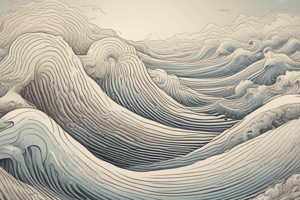Podcast
Questions and Answers
What causes mechanical waves?
What causes mechanical waves?
Mechanical waves are produced when a source of energy causes a medium to vibrate.
What is vibration?
What is vibration?
Vibration is a repeated back-and-forth or up-and-down motion.
What are the two types of waves and how are they classified?
What are the two types of waves and how are they classified?
Mechanical waves are classified by how they move; there are two types of mechanical waves: transverse waves and longitudinal waves.
What are transverse waves?
What are transverse waves?
What is a crest?
What is a crest?
What is a trough?
What is a trough?
What are longitudinal waves?
What are longitudinal waves?
What is compression?
What is compression?
What is rarefaction?
What is rarefaction?
What is amplitude?
What is amplitude?
What is wavelength?
What is wavelength?
What is frequency?
What is frequency?
What is hertz?
What is hertz?
What is the formula that relates speed, wavelength, and frequency?
What is the formula that relates speed, wavelength, and frequency?
What are the formulas for frequency and wavelength?
What are the formulas for frequency and wavelength?
What is reflection?
What is reflection?
What does the law of reflection state?
What does the law of reflection state?
What is refraction?
What is refraction?
What is diffraction?
What is diffraction?
What is interference?
What is interference?
What is constructive interference?
What is constructive interference?
What is destructive interference?
What is destructive interference?
What is a standing wave?
What is a standing wave?
What are nodes?
What are nodes?
What are antinodes?
What are antinodes?
What is resonance?
What is resonance?
What is a wave?
What is a wave?
How are mechanical waves created?
How are mechanical waves created?
How are mechanical waves classified?
How are mechanical waves classified?
Flashcards are hidden until you start studying
Study Notes
Mechanical Waves
- Caused by energy sources that cause a medium to vibrate.
- Two types: transverse and longitudinal, classified based on movement.
Vibration
- Defined as repeated back-and-forth or up-and-down motions.
Transverse Waves
- Move the medium at right angles to the wave direction.
- Particles move across the direction of the wave motion.
Key Components of Transverse Waves
- Crest: The high point of a transverse wave.
- Trough: The lowest point of a transverse wave.
Longitudinal Waves
- Move the medium parallel to the direction of wave travel.
Key Characteristics of Longitudinal Waves
- Compression: Regions where particles are closely packed.
- Rarefaction: Regions where particles are spread out.
Wave Properties
- Amplitude: Maximum distance from rest position that particles move.
- Wavelength: Distance between two corresponding points of a wave.
- Frequency: Number of completed waves passing a point in a given time.
- Hertz: SI unit for measuring frequency.
- Speed: Related mathematically by SPEED = WAVELENGTH x FREQUENCY.
Formulas
- Frequency = Speed/Wavelength
- Wavelength = Speed/Frequency
Wave Interactions
- Reflection: Waves bounce back after hitting a surface.
- Law of Reflection: Angle of incidence equals angle of reflection.
Refraction and Diffraction
- Refraction: Bending of waves when entering a new medium at an angle.
- Diffraction: Waves bend and spread around barriers or through openings.
Interference
- Interaction between waves that meet.
- Two types:
- Constructive Interference: Waves combine to create larger amplitude.
- Destructive Interference: Waves combine to create smaller amplitude.
Standing Waves
- Formed when incoming and reflected waves combine at specific frequencies.
- Appear to stand still while two waves interfere.
Nodes and Antinodes
- Nodes: Points of zero amplitude on a standing wave.
- Antinodes: Points of maximum amplitude on a standing wave.
Resonance
- An increase in amplitude when external vibrations match an object's natural frequency.
Waves
- Defined as disturbances that transfer energy from one location to another.
Studying That Suits You
Use AI to generate personalized quizzes and flashcards to suit your learning preferences.




